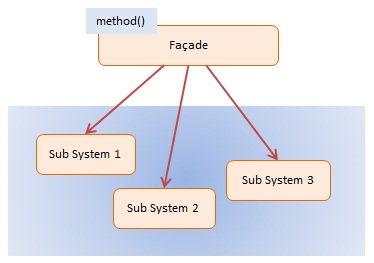Provide a unified interface to a set of interfaces in a subsystem. Façade defines a higher-level interface that makes the subsystem easier to use.
| Usage in JavaScript: |
|
high |
The Façade pattern provides an interface which shields clients from complex functionality in one or more subsystems. It is a simple pattern that may seem trivial but it is powerful and extremely useful. It is often present in systems that are built around a multi-layer architecture.
The intent of the Façade is to provide a high-level interface (properties and methods) that makes a subsystem or toolkit easy to use for the client.
On the server, in a multi-layer web application you frequently have a presentation layer which is a client to a service layer. Communication between these two layers takes place via a well-defined API. This API, or façade, hides the complexities of the business objects and their interactions from the presentation layer.
Another area where Façades are used is in refactoring. Suppose you have a confusing or messy set of legacy objects that the client should not be concerned about. You can hide this code behind a Façade. The Façade exposes only what is necessary and presents a cleaner and easy-to-use interface.
Façades are frequently combined with other design patterns. Facades themselves are often implemented as singleton factories.

The Mortgage object is the Facade in the sample code. It presents a simple interface to the client with only a single method: applyFor. Eut underneath this simple API lies considerable complexity.
The applicant's name is passed into the Mortgage constructor function. Then the applyFor method is called with the requested loan amount. Internally, this method uses services from 3 separate subsystems that are complex and possibly take some time to process; they are Bank, Credit, and Background.
Based on several criteria (bank statements, credit reports, and criminal background) the applicant is either accepted or denied for the requested loan.
var Mortgage = function(name) {
this.name = name;
}
Mortgage.prototype = {
applyFor: function(amount) {
// access multiple subsystems...
var result = "approved";
if (!new Bank().verify(this.name, amount)) {
result = "denied";
} else if (!new Credit().get(this.name)) {
result = "denied";
} else if (!new Background().check(this.name)) {
result = "denied";
}
return this.name + " has been " + result +
" for a " + amount + " mortgage";
}
}
var Bank = function() {
this.verify = function(name, amount) {
// complex logic ...
return true;
}
}
var Credit = function() {
this.get = function(name) {
// complex logic ...
return true;
}
}
var Background = function() {
this.check = function(name) {
// complex logic ...
return true;
}
}
function run() {
var mortgage = new Mortgage("Joan Templeton");
var result = mortgage.applyFor("$100,000");
alert(result);
}
Run
The Namespace pattern is applied to keep the code out of the global namespace. Our namespace is named Patterns.Classic. A Revealing Module named Facade returns (i.e. reveals) only a single item: the Mortgage constructor function and by associations its prototype. All other sub-systems which include Bank, Credit, and Background are maintained in the module's closure and hidden from view and access.
The Patterns object contains the namespace function which constructs namespaces non-destructively, that is, if a name already exists it won't overwrite it.
The log function is a helper which collects and displays results.
var Patterns = {
namespace: function (name) {
var parts = name.split(".");
var ns = this;
for (var i = 0, len = parts.length; i < len; i++) {
ns[parts[i]] = ns[parts[i]] || {};
ns = ns[parts[i]];
}
return ns;
}
};
Patterns.namespace("Classic").Facade = (function () {
var Bank = function () {
this.verify = function (name, amount) {
// complex logic ...
return true;
}
}
var Credit = function () {
this.get = function (name) {
// complex logic ...
return true;
}
}
var Background = function () {
this.check = function (name) {
// complex logic ...
return true;
}
}
var Mortgage = function (name) {
this.name = name;
}
Mortgage.prototype = {
applyFor: function (amount) {
// access multiple subsystems...
var result = "approved";
if (!new Bank().verify(this.name, amount)) {
result = "denied";
} else if (!new Credit().get(this.name)) {
result = "denied";
} else if (!new Background().check(this.name)) {
result = "denied";
}
return this.name + " has been " + result +
" for a " + amount + " mortgage";
}
}
return {
Mortgage: Mortgage
};
})();
function run() {
var facade = Patterns.Classic.Facade;
var mortgage = new facade.Mortgage("Joan Templeton");
var result = mortgage.applyFor("$100,000");
alert(result);
}
Run